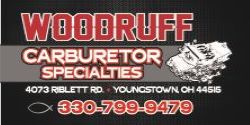Quench is a elusive thing. Hard to explain and impossible to see. From what I have read it is better described as squish but I am now expert. Just ask the experts. LOLI guess I could have avoided that tangent had I titled this thread WEDGE Quench !
You are using an out of date browser. It may not display this or other websites correctly.
You should upgrade or use an alternative browser.
You should upgrade or use an alternative browser.
With all the fanfare about quench, why then.....
- Thread starter Kern Dog
- Start date
- Local time
- 8:42 AM
- Joined
- Dec 4, 2009
- Messages
- 39,113
- Reaction score
- 55,520
- Location
- Pasadena, Texas
it's still sitting on an engine stand from 20 years ago. Has a Hemi grind Cam.....Yep, that sounds about right. I had one similar. Small cam too. No running that on pump gas.
Does yours run on pump gas? If so, what cam and timing curve.
- Local time
- 6:42 AM
- Joined
- Apr 13, 2012
- Messages
- 41,493
- Reaction score
- 150,713
- Location
- Granite Bay CA
I figured that since the car I am working on is getting open chamber iron heads, Quench is a moot point anyway. I just get curious about why Ma Mopar went one direction and then another.
I have read online about milling heads, porting, quench VS no quench...
I'm going back and forth on which engine to use but either one will end up with the same style of iron heads. I have 2 pair of 906s, a pair of '346s and 2 pair of '452s.
I pulled out the '346s to get a look at them. They look too clean to be totally original. The chambers are clean, the valve stem seals are the Viton style and it looked like the chambers were smaller. I've never checked volume on a cylinder but I've got a pretty good idea of how it is done. I've surfed around online and read about milling and reducing chamber volume.
This '346 head seemed to have a smaller chamber than the others just by a visual inspection.

Look at the step down from the deck compared to another head:

I took a Carpenters square and some feeler gauges to do a backyard, bonehead style check of how deep the chambers are in some of the other heads I have out back.



The head in the first picture had a .077 step down.
You see .090 and a .097 number too. Another set had a .101 number !
I have read online about milling heads, porting, quench VS no quench...
I'm going back and forth on which engine to use but either one will end up with the same style of iron heads. I have 2 pair of 906s, a pair of '346s and 2 pair of '452s.
I pulled out the '346s to get a look at them. They look too clean to be totally original. The chambers are clean, the valve stem seals are the Viton style and it looked like the chambers were smaller. I've never checked volume on a cylinder but I've got a pretty good idea of how it is done. I've surfed around online and read about milling and reducing chamber volume.
This '346 head seemed to have a smaller chamber than the others just by a visual inspection.
Look at the step down from the deck compared to another head:
I took a Carpenters square and some feeler gauges to do a backyard, bonehead style check of how deep the chambers are in some of the other heads I have out back.
The head in the first picture had a .077 step down.
You see .090 and a .097 number too. Another set had a .101 number !
Last edited:
Kern, my experience with dozens of pairs of BB iron heads 516, 915 (low perf & hi perf), 906, 346, & 452. The chamber volumes vary a fair amount even in the same casting numbers. Post 906 versions are slightly larger cc's. The 906 & HP 915 heads will flow essentially the same, port designs are the same. 915 CR change may be worth something depending on the rest of the combination. I'm remain convinced the chamber design change from 915's to 906's was based on the new emission regulations & projected reduced NOX emissions with 906 design. BTW, my motors with the 906 or 915 had a deck of either -.010 or -.020 with aftermarket pistons.
Ceedawg
Well-Known Member
Tired of reading but here goes, real world experience. 383 with Manly pistons (trw) pop ups, zeros deck height, .040 fel pro gasket, 67 head with back cut valves. This little engine ran within a tenth of the best 440s so the combo must have been right. Also the 68-69 440 guys with stock engines would add the 67 head to up the compression since the piston up higher than the 67. With 260 Sonoco compression wasn’t a problem.
Also at the time 1.88 max exhaust valves where used, woke that 440 up big time more so than the 1.81s. I think they worked better with the lower lift cams of that period.
Also at the time 1.88 max exhaust valves where used, woke that 440 up big time more so than the 1.81s. I think they worked better with the lower lift cams of that period.
33 IMP
Well-Known Member
- Local time
- 6:42 AM
- Joined
- Dec 21, 2017
- Messages
- 14,696
- Reaction score
- 25,076
- Location
- taxifornia,soon 2b Arizona.
Kern, take this with a grain of salt, cause I'm going by memory....
That 346 head does look smaller, maybe milled some. Memory says you can tell how much a big block mopar head has been milled, by measuring the outside row of head bolt holes. Untouched , they are supposed to be an inch, if the head bolt boss measures .950, they have been milled .050 etc. Anybody out there confirm this?
That 346 head does look smaller, maybe milled some. Memory says you can tell how much a big block mopar head has been milled, by measuring the outside row of head bolt holes. Untouched , they are supposed to be an inch, if the head bolt boss measures .950, they have been milled .050 etc. Anybody out there confirm this?
I have a couple of 906's that I believe are virgin, measures 1.003 -1.000 on the outer head bolt. My milled 906 is .940.Pretty sure I milled them about .060. I think the 1 inch makes sense to me.
BSB67
Well-Known Member
Kern, take this with a grain of salt, cause I'm going by memory....
That 346 head does look smaller, maybe milled some. Memory says you can tell how much a big block mopar head has been milled, by measuring the outside row of head bolt holes. Untouched , they are supposed to be an inch, if the head bolt boss measures .950, they have been milled .050 etc. Anybody out there confirm this?
Heard this from some reliable sources, not just internet chatter. Never measured myself. I think I have 6 sets of 906/915s laying around here for the last 35 years, either virgin, or just a clean-up. Maybe I'll measure them one day.
beanhead
Easily Offensive
I know you're talking other head castings, but all the un-skimmed 452s I have measure 1.00" on the bolt flange, if it mattters to anyone...Heard this from some reliable sources, not just internet chatter. Never measured myself. I think I have 6 sets of 906/915s laying around here for the last 35 years, either virgin, or just a clean-up. Maybe I'll measure them one day.
PRHeads
Well-Known Member
- Local time
- 9:42 AM
- Joined
- Aug 31, 2018
- Messages
- 2,312
- Reaction score
- 3,616
- Location
- So. Burlington Vt
I have a customer in the south that builds a fair number of resto-type motors.
Most of those get exhaust manifolds and stock heads.
Years ago he learned that for those builds, no quench = detonation.
Now, all the builds are done with goal of having good quench.
We don’t really try and push the envelope of the CR either.
They’re not racing these things. The owners just want them to run well on pump gas......91 octane where he’s at.
We’re happy with mid-9’s for CR, along with a decent quench distance.
Most of those get exhaust manifolds and stock heads.
Years ago he learned that for those builds, no quench = detonation.
Now, all the builds are done with goal of having good quench.
We don’t really try and push the envelope of the CR either.
They’re not racing these things. The owners just want them to run well on pump gas......91 octane where he’s at.
We’re happy with mid-9’s for CR, along with a decent quench distance.
wyrmrider
Well-Known Member
Post 15 Hemi's run better with some squish aka quench pads or around the bore
post 21 agree however a little squish helps and can reduce the amount of advance needed
post 22 not that simple I'd rather tune 10:1 with quench/ squish than 8:1 piston down the hole. When it's a little ping open chamber quench can stop it
even though you raise compression slightly
post 23 Quench is in the piston dome on open chamber if the dome is on the intake side but not with a conventional dome see #27
post 24 If running lower timing is more efficient then Yes
post 27 Big domes can block flame travel especially in the low plug BBM Big problem with max wedge Fire slots were a bandaid
we raised the compression height to 0 deck and lowered the dome to stay legal with blueprinted SS motors
#28 and did anyone really get Max Wedge 1.88 exhaust to work in other heads?
BTW larger valves without bowl work do not help a bunch except a very low lifts#
#39 toolman mike linked https://www.dragzine.com/tech-stori...ormance-squished-between-the-piston-and-head/ nothing wrong with that article
or John Erbs in the earlier post erb is talking more about Squish and where this article is talking about hot spots whell that's one thing quench helps with
post 50
Years ago he learned that for those builds, no quench = detonation.
Now, all the builds are done with goal of having good quench.
Agree
post 21 agree however a little squish helps and can reduce the amount of advance needed
post 22 not that simple I'd rather tune 10:1 with quench/ squish than 8:1 piston down the hole. When it's a little ping open chamber quench can stop it
even though you raise compression slightly
post 23 Quench is in the piston dome on open chamber if the dome is on the intake side but not with a conventional dome see #27
post 24 If running lower timing is more efficient then Yes
post 27 Big domes can block flame travel especially in the low plug BBM Big problem with max wedge Fire slots were a bandaid
we raised the compression height to 0 deck and lowered the dome to stay legal with blueprinted SS motors
#28 and did anyone really get Max Wedge 1.88 exhaust to work in other heads?
BTW larger valves without bowl work do not help a bunch except a very low lifts#
#39 toolman mike linked https://www.dragzine.com/tech-stori...ormance-squished-between-the-piston-and-head/ nothing wrong with that article
or John Erbs in the earlier post erb is talking more about Squish and where this article is talking about hot spots whell that's one thing quench helps with
post 50
Years ago he learned that for those builds, no quench = detonation.
Now, all the builds are done with goal of having good quench.
Agree
33 IMP
Well-Known Member
- Local time
- 6:42 AM
- Joined
- Dec 21, 2017
- Messages
- 14,696
- Reaction score
- 25,076
- Location
- taxifornia,soon 2b Arizona.
May i ask a question Dwayne. If these are iron head/exhaust manifold engines, with quench, i'm assuming quench dome pistons, and if they are mid nine c.r., i'm assuming a dish opposite the quench dome. Not all of these motors can be 915 head engines ,can they?I have a customer in the south that builds a fair number of resto-type motors.
Most of those get exhaust manifolds and stock heads.
Years ago he learned that for those builds, no quench = detonation.
Now, all the builds are done with goal of having good quench.
We don’t really try and push the envelope of the CR either.
They’re not racing these things. The owners just want them to run well on pump gas......91 octane where he’s at.
We’re happy with mid-9’s for CR, along with a decent quench distance.
So my question would be.....whose pistons are being used, and are they all hypereutecticsl or are forged available?
MoparDanMan
Well-Known Member
Stretch the truth? Have you ever read the fine print on a used car contact? It says that unless it is written in the space on the front of the contract they can not be held to what they tell you. They can actually lie to you legally. It even has a name..... Sales Puffery. Look it up.How long have you been playing with cars Greg? (Kidding). Manufacturers advertised specs weren't based on facts... Car salesmen are allot like politicians... They stretch the truth....
- Local time
- 6:42 AM
- Joined
- Apr 13, 2012
- Messages
- 41,493
- Reaction score
- 150,713
- Location
- Granite Bay CA
Yeah, how else can you get quench with open chamber heads ?May i ask a question Dwayne. If these are iron head/exhaust manifold engines, with quench, i'm assuming quench dome pistons, and if they are mid nine c.r., i'm assuming a dish opposite the quench dome. Not all of these motors can be 915 head engines ,can they?
So my question would be.....whose pistons are being used, and are they all hypereutectics or are forged available?
chtampa
Well-Known Member
69 383 RR motors had positive deck height pistons that increased compression and created the Magnum with the change to open chamber heads. It was a trick to run the 67 closed chamber heads to increase the compression and still protect the pistons via the head gasket. The pistons are discontinued now but when replacing the pistons back in the 70's you had to specify flat or positive when ordering parts.
BSB67
Well-Known Member
69 383 RR motors had positive deck height pistons that increased compression and created the Magnum with the change to open chamber heads. It was a trick to run the 67 closed chamber heads to increase the compression and still protect the pistons via the head gasket. The pistons are discontinued now but when replacing the pistons back in the 70's you had to specify flat or positive when ordering parts.
I think you mean 68 and 69. I'm yet to be convinced that any factory 383 piston was actually proud on an uncut factory block. Factory tolerances being what they are, I suspect that it is possible, but I believe that it would be the exception.
chtampa
Well-Known Member
Never did a 68 motor, so I only speak about what I had actual experience with. Also it is in the DC Racing Manual 1979 about Head Swapping. It does mention 68-69 on page 53 Bulletin #2.I think you mean 68 and 69. I'm yet to be convinced that any factory 383 piston was actually proud on an uncut factory block. Factory tolerances being what they are, I suspect that it is possible, but I believe that it would be the exception.
- Local time
- 8:42 AM
- Joined
- Dec 4, 2009
- Messages
- 39,113
- Reaction score
- 55,520
- Location
- Pasadena, Texas
I've found that stock heads do vary from chamber to chamber but for an everyday passenger car use, it's not that big of a deal. Have also found that the majority of the 906-452 heads had one end chamber that was a good bit different just like you found but iirc, the end chamber was smaller. Btw, I used a horse syringe to fill a chamber for checking. You can buy a 'kit' but wasn't doing that much head work to spend the money. Besides, I could level the head and do pretty much the same thing with what I had on hand and getting the big syringes was real easy and cheap at the local feed store. Also, is that square a Swanson Speed Square?I figured that since the car I am working on is getting open chamber iron heads, Quench is a moot point anyway. I just get curious about why Ma Mopar went one direction and then another.
I have read online about milling heads, porting, quench VS no quench...
I'm going back and forth on which engine to use but either one will end up with the same style of iron heads. I have 2 pair of 906s, a pair of '346s and 2 pair of '452s.
I pulled out the '346s to get a look at them. They look too clean to be totally original. The chambers are clean, the valve stem seals are the Viton style and it looked like the chambers were smaller. I've never checked volume on a cylinder but I've got a pretty good idea of how it is done. I've surfed around online and read about milling and reducing chamber volume.
This '346 head seemed to have a smaller chamber than the others just by a visual inspection.
View attachment 950399
Look at the step down from the deck compared to another head:
View attachment 950400
I took a Carpenters square and some feeler gauges to do a backyard, bonehead style check of how deep the chambers are in some of the other heads I have out back.
View attachment 950401 View attachment 950402 View attachment 950403
The head in the first picture had a .077 step down.
You see .090 and a .097 number too. Another set had a .101 number !
- Local time
- 6:42 AM
- Joined
- Apr 13, 2012
- Messages
- 41,493
- Reaction score
- 150,713
- Location
- Granite Bay CA
Ha! It was a generic speed square but I have used the Swanson ones for years!
wyrmrider
Well-Known Member
big mill or weld up the chambersYeah, how else can you get quench with open chamber heads ?
been there done that
quench dome is the answer
or custom pistons done that lots of times too
Similar threads
- Replies
- 8
- Views
- 2K















